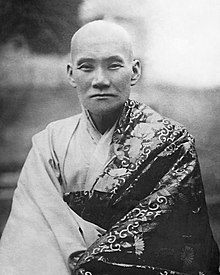Hanam Jungwon
| Hanam Jungwon 漢巖重遠 |
|
|---|---|

Hanam Jungwon between 1926-1935
|
|
| Religion | Buddhist |
| School | Jogye Order of Korean Buddhism |
| Dharma names | Hanam Jungwon 漢巖重遠 |
| Personal | |
| Nationality | Korean |
| Born | March 27, 1876 Hwacheon, Gangwon Province, Korea |
| Died | March 21, 1951 (age 74) Sangwon Temple, Odae Mountains, South Korea |
| Senior posting | |
| Title | Dae Jong Sa (Great Head of the Order) |
| Religious career | |
| Teacher | Gyeongheo Seong-u 鏡虛 惺牛 (1846-1912) |
| Works | Spiritual Head of the Jogye Order(宗正), head of the meditation hall at Sangwon Temple |
Hanam Jungwon (1876–1951, 漢巖重遠) was a Korean Buddhist monk and Seon master. He was also the spiritual head(宗正) of what was to become the modern Jogye Order of Korean Buddhism. He was the Dharma disciple of Gyeongheo Seongu (鏡虛 惺牛,1846-1912), and the Dharma brother of Woelmyeon Mangong (月面滿空, 1871-1946).
Hanam Sunim was born to an upper-class family in 1876 and received a traditional education in the Confucian classics, but at the age of 20, he left home and became a monk. He entered Jangan Temple(長安寺) and his guiding sunim was Haenglŭm Kŭmwŏl. Some time later he left there to continue his studies at Singye Temple(神溪寺). After several years, he came across a passage by the Koryo Dynasty Seon Master, Bojo Jinul, in Secrets on Cultivating the Mind:
If they aspire to the path of the Buddha while obstinately holding to their feelings that the Buddha is outside the mind or the Dharma outside the nature, then, even though they pass through kalpas as numerous as dust motes, burning their bodies, charring their arms, crushing their bones and exposing heir marrow, or else copying sutras with their own blood, never laying down to sleep, eating only one offering a day at the hour of the Hare (5-7 a.m.), or even studying through the entire Tripitaka and cultivating all sorts of ascetic practices, all of this is like trying to make rice by boiling sand―it will only add to their tribulation (Buswell 1983: 140-141).
This precipitated his first enlightenment experience, in 1899.
The essence of that passage, "don't search for the Buddha outside of yourself," stayed with Hanam Sunim throughout his life.
After Hanam Sunim's first enlightenment experience, he made his way south to Sudo Hermitage,9 he met Kyŏnghŏ Sunim.10 Meeting Hanam Sunim, Kyŏnghŏ Sunim quoted the following phrase from the Diamond Sutra:
If one sees all forms as non-form, then can one directly see the Tathagata" (T.8.749a24-25).
Upon hearing this, Hanam Sunim experienced a second enlightenment, and "felt that the whole universe could be seen in one glance and whatever was to be heard or seen was nothing other than that which was within himself." He composed the following poem:
Under my feet, the blue sky, overhead, the earth.
Inherently there is no inside or outside or middle.
The lame person walks and the blind person sees.
The north mountain answers the south mountain without words.(Pang 1996: 453)
From 1899 to 1903, Hanam Sunim spent the retreat seasons either studying under Kyŏnghŏ Sunim or attending retreat seasons at other meditation halls in the region. They spent the summer retreat season of 1903 together at Haein Temple, and later that fall, Kyŏnghŏ Sunim headed north by himself. He died in 1912.
...
Wikipedia
